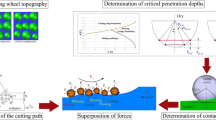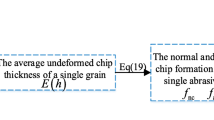Abstract
The ability to predict grinding force and power is important to many aspects of grinding process optimization, monitoring, and control. This paper presents the predictive modeling of grinding force and power based on the probabilistic distribution of undeformed chip thickness as a function of the kinematic conditions, material properties, wheel microstructure, and dynamic effects. The chip thickness is the main random variable and it is expected to assume a Rayleigh probability density function. The model takes into account the microstructure of the grinding wheel given by the grain geometry and the static grain density in terms of the radial depth into the wheel. The dynamic cutting edge density was calculated incorporating the effects of kinematic and dynamic phenomena such as the kinematic hidden grains and the local grain deflection. The elastic deformation of the grinding contact length was also considered. The model was used to predict the total tangential and normal forces in surface grinding and the total grinding power in cylindrical grinding. In both cases experimental measurement data in the context of chip thickness probability density, tangential force, normal force, and power have been presented and compared to model calculations.
Similar content being viewed by others
References
Malkin S (1989) Grinding technology. Theory and applications of machining with abrasives. Ellis Horwood, New York
Tönshoff H, Peters J, Inasaki I, Paul T (1992) Modeling and simulation of grinding processes. Ann CIRP 42(2):677–688
Law S, Wu S (1973) Simulation study of grinding process. J Eng Ind 92:972–978
Law S, Wu S, Joglekar A (1973) On building models for the grinding process. J Eng Ind 92:983–991
Basuray P, Sahay B, Lal G (1981) Surface generated if fine grinding. Part 1. Probabilistic model. Int J Prod Res 19(6):677–788
Basuray P, Sahay B, Lal G (1981) Surface generated if fine grinding. Part 2. Radial distribution parameter and simulated surface profile. Int J Prod Res 19(6):689–702
König W, Lortz W (1975) Properties of cutting edges related to chip formation in grinding. Ann CIRP 24(1):231–235
Chen X, Rowe W (1996) Analysis and simulations of the grinding process part II: mechanics of grinding. Int J Mach Tools Manuf 36(8):883–896
Zhou X, Xi F (2002) Modeling and predicting surface roughness of the grinding process. Int J Mach Tools Manuf 42:969–977
Inasaki I (1996) Grinding process simulation based on the wheel topography measurement. Ann CIRP 45(1):347–350
Steffens K (1983) Closed loop simulation of grinding. Ann CIRP 32(1):255–259
Badger J, Torrance A (2000) A comparison of two models to predict the grinding force from wheel surface topography. Int J Mach Tools Manuf 40:1099–1120
Shaw M (1972) Fundamentals of grinding. Proceeding of the international grinding conference: new developments in grinding. Pittsburgh, PA, pp 221–258
Younis MA, Alawi H (1984) Probabilistic analysis of the surface grinding process. Trans CSME 8(4):208–213
Rowe W, Morgan M, Qi H, Zheng H (1993) The effect of deformation on the contact area in grinding. Ann CIRP 42(1):409–412
Hecker RL, Ramoneda I, Liang SY (2003) Static and dynamic wheel microstructure characterization. Trans North Am Manuf Res Inst Soc Manuf Eng
Verkerk J, Peters J (1977) Final report concerning CIRP cooperative work on the characterization of grinding wheel topography. Ann CIRP 26(2):385–395
Lal G, Shaw M (1975) The role of grain tip radius in fine grinding. J Eng Ind pp 1119–1125
König W, Steffens K, Ludewig T (1985) Single grit test to reveal the fundamental mechanism in grinding. Milton Shaw grinding symposium, Miami Beach, Florida, pp.141–154
Samuels L (1972) Abrasive surface finishing processes: mechanisms. Proceeding of the international grinding conference: new developments in grinding. Pittsburgh, PA, pp 283–304
Subhash G, Koeppel B, Chandra A (1999) Dynamic indentation hardness and rate sensitivity in metals. J Eng Mater Technol 121:257–263
Shaw M (1996) Principles of abrasive processing. Oxford University Press, New York, ch 4
Author information
Authors and Affiliations
Corresponding author
Rights and permissions
About this article
Cite this article
Hecker, R.L., Liang, S.Y., Wu, X.J. et al. Grinding force and power modeling based on chip thickness analysis. Int J Adv Manuf Technol 33, 449–459 (2007). https://doi.org/10.1007/s00170-006-0473-y
Received:
Accepted:
Published:
Issue Date:
DOI: https://doi.org/10.1007/s00170-006-0473-y




